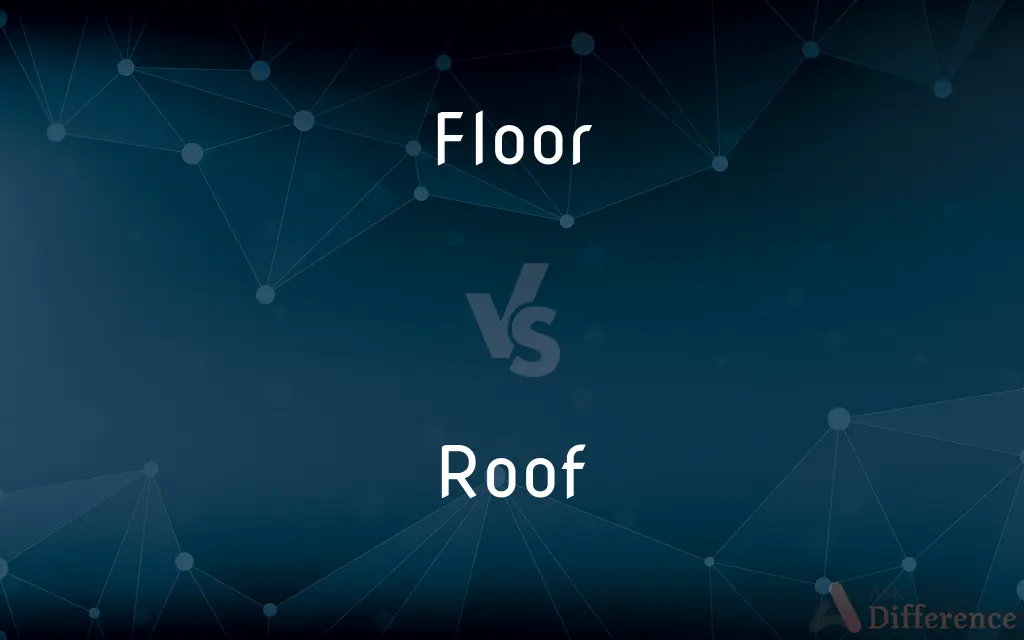Floor vs. Roof — What's the Difference?
By Maham Liaqat & Fiza Rafique — Updated on February 28, 2024
A floor is the bottom surface of a room or vehicle, providing a foundation for occupants and furniture, while a roof is the top covering of a building, offering protection against weather and external elements.

Difference Between Floor and Roof
Table of Contents
ADVERTISEMENT
Key Differences
The floor serves as the primary surface of a room or space on which people walk and place furniture. It's fundamental to the structural integrity and usability of a building's interior. Floors can be made from various materials, including wood, concrete, and tile, each chosen for its durability, aesthetics, and the specific needs of the space. The roof, conversely, is designed to shield the interior of a building from rain, snow, sun, wind, and temperature extremes. It can be flat or sloped, depending on the architectural style and functional requirements, and is constructed from materials like shingles, metal, or tiles, selected for their protective qualities and energy efficiency.
Floors and roofs play crucial but distinct roles in the comfort, safety, and energy efficiency of a building. The floor's design is integral to the comfort and aesthetic appeal of a space, often featuring insulation for warmth and noise reduction. Roofs, however, are key to a building's weatherproofing and thermal insulation, often incorporating features like vents and gutters to manage water and airflow.
The primary function of a floor is to provide a stable and level surface for interior activities, roofs are engineered to manage environmental interactions, including drainage and sometimes hosting equipment like solar panels. This difference highlights the floor's role in defining the livability of interior spaces versus the roof's in ensuring the building's overall resilience and efficiency.
The maintenance and construction challenges associated with floors and roofs differ significantly. Flooring might require regular cleaning, occasional repair, or replacement due to wear or aesthetic updates. Roof maintenance, on the other hand, is critical for preventing water damage and involves inspections, repairs, or replacements of shingles, flashing, and sealing to ensure the building remains dry and insulated.
Both floors and roofs are essential components of a building's structure, their purposes, construction materials, and maintenance requirements reflect their distinct roles in providing internal support and external protection, respectively.
ADVERTISEMENT
Comparison Chart
Function
Provides a stable surface for walking and placing objects.
Protects the interior from weather and external conditions.
Materials
Wood, concrete, tile, carpet.
Shingles, metal, tiles, thatch.
Design Concerns
Durability, aesthetics, comfort (insulation and noise reduction).
Weatherproofing, drainage, insulation, and sometimes energy generation (solar panels).
Maintenance
Cleaning, repair or replacement due to wear.
Inspections, repairs to prevent water damage, replacement of materials.
Role in Building
Fundamental to interior structural integrity and usability.
Critical for exterior protection, energy efficiency, and weather resistance.
Compare with Definitions
Floor
Floors can include several layers, such as underlayment for insulation.
The underlayment beneath the carpet floor keeps it warm and quiet.
Roof
They come in various shapes and materials, depending on climate and style.
The cabin's sloped roof was designed to prevent snow accumulation.
Floor
Maintenance involves cleaning, and sometimes replacement, for wear or style updates.
The stained carpet floor was replaced with laminate for a fresh look.
Roof
Roofs incorporate features like insulation and ventilation for comfort.
Proper roof ventilation prevents heat buildup in the attic during summer.
Floor
Flooring choices affect a room's aesthetics and functionality.
The kitchen's tile floor was chosen for its ease of cleaning.
Roof
Roofs are the top covering of buildings, shielding them from the elements.
The new roof was equipped with solar panels for energy efficiency.
Floor
A floor is the bottom surface of a room or vehicle. Floors vary from simple dirt in a cave to many-layered surfaces made with modern technology.
Roof
Maintenance is crucial for preventing leaks and extending lifespan.
Regular roof inspections help identify and repair damaged shingles.
Floor
Floors are the bottom surfaces of rooms, providing a base for occupants and furniture.
The hardwood floor added warmth and elegance to the living room.
Roof
Roofs may also serve aesthetic purposes, contributing to a building's overall design.
The terracotta roof tiles added a Mediterranean charm to the house.
Floor
They must be durable to withstand foot traffic and furniture weight.
The concrete floor in the warehouse was designed for heavy machinery.
Roof
A roof is the top covering of a building, including all materials and constructions necessary to support it on the walls of the building or on uprights, providing protection against rain, snow, sunlight, extremes of temperature, and wind. A roof is part of the building envelope.
Floor
The surface of a room on which one stands.
Roof
The structure forming the upper covering of a building or vehicle
A car with a vinyl roof
A thatched roof
The rain woke him, hammering on the roof
Roof timbers
Floor
The lower or supporting surface of a structure.
Roof
Cover with a roof
The yard had been roughly roofed over with corrugated iron
Floor
The interior bottom or surface of a house or building; the supporting surface of a room.
The room has a wooden floor.
Roof
The exterior surface and its supporting structures on the top of a building.
Roof
The upper exterior surface of a dwelling as a symbol of the home itself
Three generations living under one roof.
Roof
The top covering of something
The roof of a car.
Roof
The highest point or limit; the summit or ceiling
A roof on prices is needed to keep our customers happy.
Roof
(architecture) The external covering at the top of a building.
The roof was blown off by the tornado.
Roof
The cover of any building, including the roofing (see Roofing) and all the materials and construction necessary to carry and maintain the same upon the walls or other uprights. In the case of a building with vaulted ceilings protected by an outer roof, some writers call the vault the roof, and the outer protection the roof mask. It is better, however, to consider the vault as the ceiling only, in cases where it has farther covering.
Roof
A protective covering that covers or forms the top of a building
Roof
Provide a building with a roof; cover a building with a roof
Common Curiosities
Can the design of a roof affect a building's energy efficiency?
Yes, roofs play a significant role in a building's thermal insulation and can support energy generation through solar panels.
How often should roofs be inspected or maintained?
Roofs should be inspected at least annually or after severe weather events to ensure they remain in good condition.
What factors influence the choice of flooring material?
Considerations include foot traffic, moisture exposure, aesthetic preference, and the need for noise or thermal insulation.
Why is proper ventilation important for roofs?
Ventilation helps manage temperature and moisture in the attic, preventing heat buildup and reducing the risk of mold and structural damage.
Can roof designs be customized to match architectural styles?
Yes, roofs can be designed in various shapes and with different materials to complement a building's architectural style.
Why are different materials used for floors and roofs?
Materials are chosen based on the specific needs of either surface, including durability for floors and weather resistance for roofs.
Is it possible to retrofit roofs for better energy efficiency?
Yes, existing roofs can be upgraded with better insulation, reflective materials, or solar panels to improve energy efficiency.
How does the structure of a floor contribute to a building's stability?
Floors provide crucial support for interior loads and contribute to the overall structural integrity of the building.
What are the environmental considerations for choosing roofing materials?
Factors include the material's longevity, recyclability, and its impact on the building's thermal efficiency.
How can floors enhance the aesthetic appeal of a room?
Through material, color, and pattern choices, floors can significantly contribute to a room's design theme and ambiance.
Share Your Discovery

Previous Comparison
Trap vs. Rap
Next Comparison
Lying vs. DeceptionAuthor Spotlight
Written by
Maham LiaqatCo-written by
Fiza RafiqueFiza Rafique is a skilled content writer at AskDifference.com, where she meticulously refines and enhances written pieces. Drawing from her vast editorial expertise, Fiza ensures clarity, accuracy, and precision in every article. Passionate about language, she continually seeks to elevate the quality of content for readers worldwide.














































